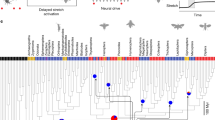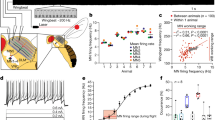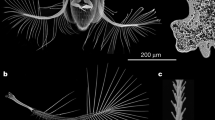Abstract
HIGH wingbeat frequencies are required for flight in many insects, and have led to striking specialisations1. The thorax and wings form a resonant system whose oscillation is sustained by alternating contractions of antagonistic muscles. The action of these flight muscles is to produce only a small-amplitude deformation of the thorax, mechanically amplified into wing movements. The muscles are diverse in arrangement1 and ultrastructure2. In several insect orders, they are of a characteristic ‘fibrillar’ type whose very regular architecture is well known3. As recognised largely through the work of Pringle4, certain properties of fibrillar muscle permit more rapid wing-beats because the oscillation does not depend on pacemaking neural input: the muscles receive only slow and irregular stimulation, and the contraction of each is triggered, after a delay, directly by the stretch applied to it while its antagonist shortens. Studies of isolated glycerol- extracted fibrillar muscle fibres show that unusual properties underlying this sensitivity to stretch are intrinsic to the contractile apparatus itself5. ATPase levels and tension are low in calcium-activated fibres at rest length, but are increased by slight extension (0.1–5%). The muscles exhibit both actin-linked and myosin-linked regulation typical of many invertebrate muscles6, and the additional regulatory effects of mechanical conditions are not understood. Stretch has been presumed to modify cross-bridge attachment by some unknown effect on the myosin filamenats4 (possibly transmitted through structures which connect them to the Z-line in certain insect muscles7). I suggest here that many aspects of stretch–activation in fibrillar muscles may be explained by the particular geometry of their myosin and actin filaments.
This is a preview of subscription content, access via your institution
Access options
Subscribe to this journal
Receive 51 print issues and online access
$199.00 per year
only $3.90 per issue
Buy this article
- Purchase on Springer Link
- Instant access to full article PDF
Prices may be subject to local taxes which are calculated during checkout
Similar content being viewed by others
References
Pringle, J. W. S. in The Physiology of Insecta Vol. 3, 2nd edn (ed. Rockstein M.) 433–476 (Academic, New York, 1974).
Auber, J. Am. Zool. 7, 451–456 (1967).
Reedy, M. K. J. molec. Biol. 31, 155–176 (1968).
Pringle, J. W. S. Proc. R. Soc. B201, 107–130 (1978).
Jewell, B. R. & Rüegg, J. C. Proc. R. Soc. B164, 427–459 (1966).
Lehman, W., Bullard, B. & Hammond, K. J. gen. Physiol. 63, 553–563 (1974).
Auber, J. & Couteaux, R. J. Microsc. 2, 309–324 (1963).
Miller, A. & Tregear, R. T. J. molec. Biol. 70, 85–104 (1972).
Wray, J. S. Nature 277, 37–40 (1979).
Squire, J. M. J. molec. Biol. 72, 125–138 (1972).
Huxley, A. F. & Simmons, R. M. Nature 233, 533–538 (1971).
Thorson, J. & White, D. C. S. Biophys. J. 9, 360–390 (1969).
Abbott, R. H. & Cage, P. E. J. Physiol., Lond. 289, 32P–33P (1979).
Chaplain, R. A. Pflügers Arch. ges. Physiol. 321, 223–232 (1969).
Pybus, J. & Tregear, R. J. Physiol., Lond. 247, 71–89 (1975).
Author information
Authors and Affiliations
Rights and permissions
About this article
Cite this article
WRAY, J. Filament geometry and the activation of inisect flight muscles. Nature 280, 325–326 (1979). https://doi.org/10.1038/280325a0
Received:
Accepted:
Issue Date:
DOI: https://doi.org/10.1038/280325a0
This article is cited by
-
The earliest molecular response to stretch of insect flight muscle as revealed by fast X-ray diffraction recording
Scientific Reports (2017)
-
The roles of troponin C isoforms in the mechanical function of Drosophila indirect flight muscle
Journal of Muscle Research and Cell Motility (2014)
-
Flight of the bumblebee decoded
Nature (2013)
-
Regulating the contraction of insect flight muscle
Journal of Muscle Research and Cell Motility (2011)
-
Muscle myosin filaments: cores, crowns and couplings
Biophysical Reviews (2009)
Comments
By submitting a comment you agree to abide by our Terms and Community Guidelines. If you find something abusive or that does not comply with our terms or guidelines please flag it as inappropriate.



